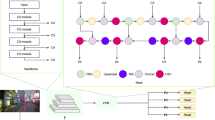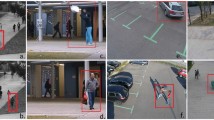Abstract
This paper proposes Cyber-Physical System (CPS) architectures for Large Scale Intelligent and Cooperative Surveillance (ICS) and presents an Adaptive Network-based Fuzzy Inference Model (ANFIM) for reducing the false accident-event report rates of Controller Manager (CM) systems among CPS components. In ICS, sensor nodes detect traffic accident events from general roads and crossroads and transmit event attribute values (car and accident types), time attribute values (date, month, day, year), environmental variable values (weather, temperature, luminous intensity, humidity and sound), and accident event videos to the Controller through WSN mesh networks. Using these pieces of information, the Controller conducts image processing and delivers all sensing data to the CM together with accident-event probability values. The CM conducts data filtering with multi regression analysis utilizing the past accident event database. Centering on the resultant values obtained through the foregoing process, this paper proposes a mathematical model for influence analysis of environmental variables that affect accident events. Based on the model’s results, the authors establish a Sugeno Type fuzzy rule base for reducing false accident-event report rates to propose an ANFIM.











Similar content being viewed by others
References
Wua Fang-Jing, Kaob Yu-Fen, Tseng Yu-Chee (2011) From wireless sensor networks towards cyber physical systems. Pervasive Mobile Comput. doi:10.1016/j.pmcj.2011.03.003
Sang Oh Park , Tae Hoon Do , Young-Sik Jeong, Sung Jo Kim (2001) A Dynamic Control Middleware for Cyber Physical Systems on an IPv6-based Global Network. Int J Commun Syst. doi:10.1002/dac.1382
Zhou Xi, Ge Yifan, Chen Xuxu, Jing Yinan, Sun Weiwei (2012) A distributed cache based reliable service execution and recovery approach in MANETs. J Convergence 3(1):5–12
Tariq Muhammad Umer, Nasir Hasan Arshad, Muhammad Abubakr, Wolf Marilyn (2012) Model-Driven Performance Analysis of Large Scale Irrigation Networks. the ACM/IEEE 3rd International Conference on Cyber-Physical Systems 2012, Session 6: Modeling and Verification, Apr. 2012
Bandaranayake Asitha U, Pandit Vaibhav, Agrawal Dharma P (2012) Indoor link quality comparison of IEEE 802.11a channels in a multi-radio mesh network testbed. J Inf Process Syst 8(1):1–20
Song Z et al (2009) Optimal observation for cyber-physical systems. Spinger, London
Jovanov E, Milenkovic A, Otto C, de Groen PC (2005) A wireless body area network of intelligent motion sensors for computer assisted physical rehabilitation. J Neuroeng Rehabil 2(6). http://www.jneuroengrehab.com/content/2/1/6
Poon CCY, Zhang Y-T, Bao S-D (2006) A novel biometrics method to secure wireless body area sensor networks for telemedicine and M-health. IEEE Commun Mag 44(4):73–81
Taleb T, Bottazzi D, Guizani M, Nait-Charif H (2009) ANGELAH: a framework for assisting elders at home. IEEE J Sel Areas Commun 27(4):480–494
Li Q, Rosa MD, Rus D (2003) Distributed algorithm for guiding navigation across a sensor network. In: Int’l Symp. Mobile Ad Hoc Networking and Computing, pp 313–325
Tseng Y-C, Pan M-S, Tsai Y-Y (2006) A distributed emergency navigation algorithm for wireless sensor networks. IEEE Comput 39(7):55–62
Pan M-S, Tsai C-H, Tseng Y-C (2006) Emergency guiding and monitoring applications in indoor 3D environments by wireless sensor networks. Int J Sens Netw 1(1–2):2–10
Li M, Liu Y, Wang J, Yang Z (2009) Sensor network navigation without locations. In: INFOCOM, pp 2419–2427
Han L, Potter S, Beckett G, Pringle G, Welch S, Koo S-H, Wickler G, Usmani A, Torero JL, Tate A (2010) FireGrid: an e-infrastructure for next-generation emergency response support. J Parallel Distrib Comput 70(11):1128–1141
Lo C-H, Peng W-C, Chen C-W, Lin T-Y, Lin C-S (2008) CarWeb: a traffic data collection platform. In: Int’l Conf. Mobile Data Management, pp 221–222
Mohan P, Padmanabhan VN, Ramjee R (2008) Nericell: rich monitoring of road and traffic conditions using mobile smartphones. In: Int’l Conf. Embedded Networked Sensor Systems, pp 323–336
Thiagarajan A, Ravindranath L, LaCurts K, Madden S, Balakrishnan H, Toledo S, Eriksson J (2009) Vtrack: accurate, energy-aware road traffic delay estimation using mobile phones. In: Int’l Conf. Embedded Networked Sensor Systems, pp 85–98
Thiagarajan A, Biagioni J, Gerlich T, Eriksson J (2010) Cooperative transit tracking using smart-phones. In: Int’l Conf. Embedded Networked Sensor Systems, pp 85–98
Eisenman SB, Miluzzo E, Lane ND, Peterson RA, Ahn GS, Campbell AT (2007) The BikeNet mobile sensing system for cyclist experience mapping. In: Int’l Conf. Embedded Networked Sensor Systems, pp 87–101
Mathur S, Jin T, Kasturirangan N, Chandrashekharan J, Xue W, Gruteser M, Trappe W (2010) ParkNet: drive-by sensing of road-side parking statistics. In: Int’l Conf. on Mobile Systems, Applications, and Services, pp 123–136
Al-Khateeb KAS, Johari JA, Al-Khateeb WF (2008) Dynamic traffic light sequence algorithm using RFID. J Comput Sci 4(7):517–524
Miluzzo E, Lane ND, Fodor K, Peterson R, Lu H, Musolesi M, Eisenman SB, Zheng X, Campbell AT (2008) Sensing meets mobile social networks: the design, implementation and evaluation of the CenceMe application. In: Int’l Conf. Embedded Networked Sensor Systems, pp 337–350
Chiu M-C, Chang S-P, Chang Y-C, Chu H-H, Chen CC-H, Hsiao F-H, Ko J-C (2009) Playful bottle: a mobile social persuasion system to motivate healthy water intake In: Int’l Conf. Ubiquitous, computing, pp. 185–194
Gaonkar S, Li J, Choudhury RR (2008) Micro-Blog: sharing and querying content through mobile phones and social participation. In: Int’l Conf. on Mobile Systems, Applications, and Services, pp 174–186
Wu C-H, Chang Y-T, Tseng Y-C (2010) Multi-screen cyber-physical video game: an integration with body-area inertial sensor networks. In: Int’l Conf. Pervasive Computing and Communications, pp 832–834
Wu F-J, Huang C-S, Tseng Y-C (2010) My Tai-Chi Book: a virtual-physical social network platform. Int’l Symp. In: Information Processing in Sensor Networks, pp 428–429
\(\text{ ONVIF }^{\rm TM}\) Streaming Specification, Streaming Spec. - Ver. 2.10, http://www.onvif.org/ Jun. (2011)
Acknowledgments
This research was supported by the IT R&D Program of MKE/KEIT [10035708, “The Development of CPS (Cyber-Physical Systems) Core Technologies for High Confidential Autonomic Control Software”].
Author information
Authors and Affiliations
Corresponding author
Rights and permissions
About this article
Cite this article
Jeong, YS., Park, J.H. Adaptive network-based fuzzy inference model on CPS for large scale intelligent and cooperative surveillance. Computing 95, 977–992 (2013). https://doi.org/10.1007/s00607-013-0317-1
Received:
Accepted:
Published:
Issue Date:
DOI: https://doi.org/10.1007/s00607-013-0317-1




